Catalan as a Heritage Language in Germany
Abstract
:1. Introduction
2. Catalan in the Diaspora
3. Previous Studies on Catalan in the Diaspora
3.1. Studies on Catalan Families outside Catalan-Speaking Regions in Spain
3.2. The Early Acquisition of Catalan as an HL
4. The Study
4.1. Participants
4.2. Methodology
4.3. Research Questions and Hypotheses
- (1)
- RQ1: Does input consistency relate to output consistency in child-parent-interactions?Hypothesis 1 (H1).If parents choose to be consistent in their speech directed to children (i.e., only Catalan/only German), bi- and multilingual children will mainly utter monolingual productions in their speech directed to the Catalan-speaking and the German-speaking parent.
- (2)
- RQ2: Do the Catalan language skills of the non-native-Catalan-speaking parent positively promote HL competence or HL fluency?Hypothesis 2 (H2).If the non-native-Catalan-speaking parent shows good language skills in this language, children might have the possibility to also interact in the HL with non-native-Catalan-speaking parents and, therefore, this might positively influence the children’s HL competence.
- (3)
- RQ3: Does input quantity in the child’s first early years have a substantial impact on HL acquisition?Hypothesis 3 (H3).If input quantity in the child’s early years positively influences HL acquisition, children who spent substantially more time with the Catalan native parent (i.e., in terms of maternity/paternity leave) may show a better linguistic competence in the HL.13
- (4)
- RQ4: Do comprehension and production activities in the HL promote a balanced competence between German and Catalan?Hypothesis 4 (H4).If the frequency in HL activities has a positive impact on HL competence, children with greater exposure to these activities in the HL should show an even competence between the heritage and the majority languages.
- (5)
- RQ5: If a family decides to exclusively use one language when all family members are present (family language) and irrespective of the family’s FLP chosen, does this decision influence the child’s language acquisition of the HL and the MaL?Hypothesis 5 (H5).If a family chooses the HL as family language, this should positively influence HL acquisition.
5. Results
5.1. Language Dominance and Language Fluency
5.2. Child-External Factors and Language Dominance
5.2.1. Family Language Policies (FLP)
5.2.2. Family Language
5.2.3. Children’s Language to the Catalan-Speaking Parent
5.2.4. Parents’ Knowledge of the L2 Catalan
5.2.5. Frequency of Comprehension and Production Activities
5.2.6. Language Exposure during the First Year of Life
| Children | Maternity Leave | Paternity Leave | Early Language Exposure |
|---|---|---|---|
| Lena (2;8,10) | 10 months (Catalan) | 2 months (German) | Catalan/German |
| Kenya (2;11,21) | 12 months (Catalan) | Catalan/German | |
| Duna (3;11,25) | 7 months (Catalan) | 2 months (Catalan) | Catalan |
| Nil (4;3,11) | 18 months (Catalan/English) | Catalan/German | |
| Pau (4;3,22) | 10 months (Thai) | 2 months (Catalan) | Catalan/Thai |
| Magalí (4;10,23) | 12 months (German) | Catalan/German | |
| Emily (5;1,16) | 6 months (Catalan) | 2 months (English) | Catalan/English |
| Jan (5;2,25) | 12 months (Catalan) | Catalan/German | |
| David (5;8,18) | 14 months (Catalan) | Catalan/German | |
| Júlia S. (5;9,16) | 11 months (Catalan) | 3 months (German) | Catalan/German |
| Mila B. (5;9,10) | 18 months (Catalan/English) | Catalan/German | |
| Dana (5;10,22) | 12 months (Catalan) | Catalan/German | |
| Julia K. (7;7,15) | 12 months (Catalan) | Catalan/German | |
| Alba (10;6,12) | 8 months (Catalan) | Catalan | |
| Mila P. (11;2,18) | 14 months (Catalan) | Catalan/German | |
| Nina (13;3,22) | 14 months (Catalan) | Catalan/German |
5.2.7. Combination of Different Child-External Factors for Language Dominance: A Descriptive Approach
6. Discussion and Future Research
Author Contributions
Funding
Institutional Review Board Statement
Informed Consent Statement
Data Availability Statement
Conflicts of Interest
Appendix A
| Input Quantity Factors | |
| Amount of input | Quant de temps a la setmana calculeu que passa la vostra filla/el vostre fill amb les persones següents del seu entorn?/Wie viel Zeit schätzt Ihr, dass Euer Kind mit den Personen seiner Umgebung verbringt? (How much time per week do you estimate your daughter/son spends with the following people in their environment?) |
| Cumulative input | Amb quina quantitat i què ha parlat cada una de les persones adultes que viuen a casa vostra amb l’infant durant cada un dels anys abans de començar amb la llar d’infants?/Wie viel und was hat jede erwachsene Person im Haus mit dem Kind jedes Jahr vor Kitaeintritt gesprochen? (How much, and what language, did each of the adults (living in your home) talk with the child during each of the years before they started kindergarten?) |
| Language strategy (LS) | Qui parla què AMB L‘INFANT?/Wer spricht was MIT DEM KIND? (Who speaks what with the child?) |
| Language constellation | Teniu una llengua o llengües familiars?/Habt Ihr eine Familiesprache(n)? (Do you have (a) family language(s)?). Quina llengua empreu per fer els deures de l’escola?/Welche Sprache nutzt Ihr für die Anfertigung der Hausaufgaben? (What language do you use to do school homework?) |
| Input quality factors | |
| Family‘s linguistic competencies | Com valores els teus coneixements en les llengües següents?/Wie schätzt Du Deine Kompetenzen in den folgenden Sprachen? (How do you value your knowledge in the following languages?) |
| Cultural contact | Quants cops a l’any aneu a una regió catalano-parlant?/Wie oft besucht Ihr eine Katalanisch sprachige Region pro Jahr? (How many times per year do you go to a Catalan-speaking region?) Quan sou a la regió catalano-parlant, quina llengua/quines llengües parleu i amb quina freqüència?/In der Katalanisch sprachigen Region, welche Sprache(n) nutzt Ihr und wie oft werden sie benutzt? (When you are in the Catalan-speaking region, what language(s) do you speak and how often?) |
| Linguistic domains | Amb quina freqüència penseu que la vostra filla/el vostre fill utilitza una de les llengües durant les següents activitats?/Wie schätz Ihr ein, wie häufig Eure Tochter/Euer Sohn die Muttersprachen bei den folgenden Aktivitäten verwendet? (How often do you think your daughter/son uses one of the languages during the following activities?) Com de sovint creieu que el vostre fill/la vostra filla empra les llengües maternes en les seves activitats cotidianes?/Wie oft schätzt Ihr ein, dass Euer Sohn/Eure Tochter die Muttersprachen für die alltäglichen Aktivitäten nutzt? (How often do you think your child uses his/her mother tongues in everyday quotidian activities?) |
| Importance of bilingualism/multilingualism to be supported in the family by its family members | Com d’important és per a tu entendre/parlar/escriure/llegir català?/Wie wichtig ist für Dich Katalanisch verstehen/spechen/schreiben/ lesen? (How important is it for you to understand/speak/write/read in Catalan?) |
| 1 | years;months. |
| 2 | Most importantly, both studies dealt with HLs that find some kind of support in the community where these bilingual children grow up. Particularly, both studies recruited bilingual families in Florida. Furthermore, Gathercole (2007) could count on bilingual families in Wales as well. In this respect, these families could take advantage of certain HL support outside the home, i.e., in the community. |
| 3 | Authors acknowledge that this is contrary to previous work, and this might be due to the fact that their sample did not contain enough extreme cases, i.e., mothers who took less than 2 weeks and more than 12 weeks. |
| 4 | Unfortunately, no information on the Catalans living in Germany who were born in this country and whose origin is the Valencian Community is available. |
| 5 | As one reviewer correctly observes, it might be the case that not all Catalan families in the diaspora choose to register their children who are born in Germany in the Catalan-speaking regions in Spain. In this respect, the number of Catalan families from Catalonia and the Balearic Islands living in the diaspora might actually be underrepresented; therefore, it consists of a larger community than the one we can interpret from the official statistical resources. |
| 6 | These studies also investigate the Galician community in this city. |
| 7 | Moreover, interviews with five Galician families with a total of 10 children were also carried out. |
| 8 | These statistical results are also valid for Spanish, but not applicable for German (Arnaus Gil et al. 2020). |
| 9 | We agree with one reviewer that adjusting the tasks that were carried out in the language recordings depending on child’s age might indirectly mask children’s productions. Put differently, games such as Guess Who trigger shorter, monoclausal sentences, while talking about a favourite series might elicit longer sentences as well as more subordinate and relative clauses. |
| 10 | Although this study focuses on German–Catalan bilingual children, four children are trilingual: three of them speak English and the other speaks Thai. We also recorded them in English and Thai conversations with their parents or other native adults. We are in the process of transcribing and analyzing these data. |
| 11 | Regarding previous bilingual studies that have used MLU and fluency in order to assess language proficiency in early childhood, we are well aware of the fact that Catalan and German differ in some aspects and these differences might thus affect the calculated MLU values for each language. For instance, German belongs to the family of non-pro-drop languages, whereas Catalan, as well as other Romance languages, can be considered pro-drop languages. In this sense, we decided to follow previous empirical studies for the German–Romance combinations as in Schmeißer et al. (2016), specifically by considering Catalan-omitted subjects in the MLU calculation. For a further description and discussion of how MLU values can be inferred across languages, cf. Yip and Matthews (2000, 2006) and Müller et al. (2007), among others. |
| 12 | One example of a question for each factor in Table 2 can be consulted in Appendix A. |
| 13 | This research question will be answered in our study with data from a cross-sectional study with 16 bi- and trilingual children. However, longitudinal data with bi- and trilingual children would contribute to answering this question as well. |
| 14 | However, its use has been controversial, when sentence length, measured in terms of MLU, is linked to syntactic complexity and, thus, to language competence (cf. Köppe 1997 and Döpke 1992 for contrary views on this topic and Arencibia Guerra 2008 for a critical discussion). |
| 15 | Yet, using MLU to calculate language proficiency and language dominance for children past age 5 or 6 remains controversial, as one reviewer notes, since children are well aware of numerous communication and linguistic skills that might shorten or lengthen their sentences. However, there are empirical studies that have used other performance criteria (e.g., words per minute) with young adults with the same objective, in the acquisition of Romance languages as heritage languages (Schmitz and Scherger 2017; Diaubalick et al. 2020). Nonetheless, we are aware of the limitations of our study concerning the use of MLU to measure language dominance on older children. Future research should add other forms of language assessment in the child’s L1s. |
| 16 | The oldest child, Nina, presents a FluencyD of 12.63 w/minute. Strictly speaking, we thus classified her as having a higher language fluency in Catalan. However, we think it could be reasonable to consider her (still) as having a similar language fluency in her two L1s, since FluencyD is extremely close to the boundary of 11.99 w/min. Put differently, Nina is less than one word per minute away (0.64 words) from being regarded as having a similar language fluency in both L1s. In this sense, the distribution of the sixteen children according to language fluency would, thus, be: ten children with similar language fluency (62.5%), five participants with a higher language fluency in German (31.25%), and one child showing a higher fluency in Catalan (6.25%). From now on, we will follow this approach. |
| 17 | Nina has also been counted in this group and not in the group ‘higher rates of language fluency in German’, for the reasons we specified in the previous footnote. |
| 18 | Since the different groups of children across the external factors are heterogeneous and, following the suggestion of one reviewer, we decided to describe the results, leaving statistical analyses aside. |
| 19 | As a reviewer correctly points out, only having oral skills does not necessarily imply less linguistic competence. In this respect, we have used the values of the Likert scales on speaking, understanding, reading, and writing in order to best capture the linguistic status of the L2 Catalan in non-native parents. |
| 20 | Note that data from Alba and Duna are missing, since they only have Catalan-speaking parents. |
| 21 | This section of the input questionnaire is based on the work by Torregrossa and Bongartz (2018). |
| 22 | Even though this paper only focuses on German and Catalan responses, the total percentages of each child also consider the percentage of the LC (Spanish, English, or Thai); that is, trilingual children present less than 100% of frequency if Catalan and German responses are combined, given that parents explained that the children also perform activities in the LC. |
| 23 | Moreover, Alba is the only child who was born in a Catalan-speaking region and did not move to Germany until age 4;0. |
References
- Aalberse, Suzanne, Ad Backus, and Pieter Muysken. 2019. Heritage Languages. A Language Contact Approach. Amsterdam/Philadelphia: John Benjamins Publishing Company. [Google Scholar]
- Arnaus Gil, Laia. 2022. Spanish and German as heritage and majority languages in early multilingual acquisition: Family Language Policies and other child-external factors for heritage language competence. International Journal of Multilingualism. To appear. [Google Scholar] [CrossRef]
- Arnaus Gil, Laia, and Natascha Müller. 2020. Els verbs copulatius catalans ésser i estar i la seva adquisició en edats primerenques. Un estudi sobre el trilingüisme precoç a Espanya i Alemanya. In Contact, variation, and change in Romance and beyond. Studies in honor of Trudel Meisenburg. Edited by Gabriel, Christoph, Andrea Pešková and Maria Selig. Berlin: Erich Schmidt, pp. 283–300. [Google Scholar]
- Arnaus Gil, Laia, Natascha Müller, Marina Hüppop, Meike Poeste, Elena Scalise, Nadine Sette, Abira Sivakumar, Mabel Tirado Espinosa, and Katharina Sonja Zimmermann. 2019. Trilinguismus. Eine Einführung mit den Sprachen Deutsch, Französisch, Katalanisch und Spanisch. Tübingen: Narr. [Google Scholar]
- Arnaus Gil, Laia, Natascha Müller, Nadine Sette, and Marina Hüppop. 2020. Active bi- and trilingualism and its influencing factors. Applied Psycholinguistics. [Google Scholar] [CrossRef]
- Arencibia Guerra, Lastenia. 2008. Sprachdominanz bei Bilingualen Kindern mit Deutsch und Französisch, Italienisch oder Spanisch als Erstsprachen. Bergische Universität Wuppertal. Available online: http://elpub.bib.uni-wuppertal.de/edocs/dokumente/fba/romanistik/diss2008/arenguerra/da0805.pdf (accessed on 9 February 2022).
- Braun, Andreas, and Tony Cline. 2014. Language Strategies for Trilingual Families. Parents’ perspectives. Bristol: Multilingual Matters. [Google Scholar]
- Buades Crespí, Joan, Mariantònia Manresa Montserrat, Antoni Marimon Riutort, and Margalida Mas Barceló. 2001. El Moviment Associatiu Balear a L’exterior. L’emigració de les Illes Balears a Ultramar. Conselleria de Presidència, Govern de les Illes Balears. Benissalem: Gràfiques Rubines, SL. [Google Scholar]
- Cantone, Katja Francesca, Tanja Kupisch, Natascha Müller, and Katrin Schmitz. 2008. Rethinking language dominance in bilingual children. Linguistische Berichte 215: 307–43. [Google Scholar]
- Casesnoves-Ferrer, Raquel, and Eva Juarros-Daussà. 2012. La influencia de la política lingüística en la transmisión del catalán y del gallego dentro y fuera de sus fronteras. In Empiricism and Analytical Tools for 21 Century Applied Linguistics. Edited by Elorza Izaskun, Ovidi Carbonell, Reyes Albarrán, Blanca García and Mirian Pérez-Veneros. Salamanca: Ediciones Universidad Salamanca, pp. 861–74. [Google Scholar]
- Casesnoves-Ferrer, Raquel, and Eva Juarros-Daussà. 2015. El catalán entre las dos lenguas más habladas del mundo. In Lengua Española, Contacto Lingüístico y Globalización. Edited by R. Terborg and A. Alarcón. México: Universidad Nacional Autónoma de México, pp. 463–92. [Google Scholar]
- CEVEX, Centre de Valencians a l’Exterior. 2020. Generalitat Valenciana. Available online: http://cevex.gva.es/va/ (accessed on 11 December 2020).
- Chevalier, S. 2015. Trilingual Language Acquisition. In Contextual Factors Influencing Active Trilingualism in Early Childhood. Amsterdam: Benjamins. [Google Scholar]
- Cobo-Lewis, Alan B., Rebecca E. Eilers, Barbara Zurer Pearson, and Vivian C. Umbel. 2002. Interdependence of Spanish and English knowledge in language and literacy among bilingual children. In Language and Literacy in Bilingual Children. Edited by K. Oller and R. Eilers. Clevedon: Multilingual Matters, pp. 118–34. [Google Scholar]
- De Houwer, Annick. 2004. Trilingual input and children’s language use in trilingual families in Flanders. In Trilingualism in Family, School and Community. Edited by C. Hoffmann and J. Ytsma. Chlevedon: Multilingual Matters, pp. 118–35. [Google Scholar]
- De Houwer, Annick. 2007. Parental language input patterns and children’s bilingual use. Applied Psycholinguistics 28: 411–24. [Google Scholar] [CrossRef]
- De Houwer, Annick. 2009. Bilingual First Language Acquisition. Bristol: Multilingual Matters. [Google Scholar]
- Diaubalick, Tim, Pedro Guijarro-Fuentes, and Katrin Schmitz. 2020. Tense and aspect in Spanish heritage speakers living in Germany. In New Trends in Language Acquisition within the Generative Perspective, Studies in Theoretical Psycholinguistics. Edited by P. Guijarro-Fuentes and C. Suárez-Gómez. Dordrecht: Springer, pp. 49–70. [Google Scholar]
- Döpke, Susanne. 1988. The role of parental teaching techniques in bilingual German-English families. International Journal of the Sociology of Language 72: 101–12. [Google Scholar] [CrossRef]
- Döpke, Susanne. 1992. One Parent One Language: An Interactional Approach. Amsterdam: John Benjamins. [Google Scholar]
- Döpke, Susanne. 2000. The interplay between language-specific development and cross-linguistic influence. In Cross-Linguistic Structures in Simultaneous Bilingualism. Edited by S. Döpke. Amsterdam: John Benjamins, pp. 79–103. [Google Scholar]
- Dunn, Lloyd, Claudia Thériault-Whalen, and Leota Dunn. 1993. Échelle de vocabulaire en images Peabody. In Adaptation Française du Peabody Picture Vocabulary Test Revised. Toronto: Pearson Canada Assessment Inc. [Google Scholar]
- Gathercole, Virginia. 2007. Miami and North Wales, so far and yet so near: A constructivist account of morphosyntactic development in bilingual children. International Journal of Bilingual Education and Bilingualism 10: 224–47. [Google Scholar] [CrossRef]
- GENCAT. 2020. Generalitat de Catalunya. Available online: https://web.gencat.cat/ca/inici (accessed on 11 December 2020).
- Grosjean, Francois. 2001. The bilingual’s language modes. In One Mind, Two Languages: Bilingual Language Processing. Edited by J. Nicol. Oxford: Blackwell, pp. 1–22. [Google Scholar]
- Hager, Malin. 2014. Der Genuserwerb bei Mehrsprachig Aufwachsenden Kindern—Eine Longitudinale Untersuchung Bilingualer und Trilingualer Kinder der Sprachenkombinationen Deutsch-Französisch/Italienisch/Spanisch, Französisch-Italienisch/Spanisch und Deutsch-Spanisch-Katalanisch. Bergische Universität Wuppertal. Available online: http://elpub.bib.uni-wuppertal.de/edocs/dokumente/fba/romanistik/diss2014/hager/da1401.pdf (accessed on 9 February 2022).
- Hawkey, James W. 2011. Towards an understanding of the contemporary sociolinguistic situation in the Pyrénées-Orientales: What questions need to be asked? Cahiers AFLS 15: 36–52. [Google Scholar]
- Hoffmann, Charlotte. 1985. Language acquisition in two trilingual children. Journal of Multilingual and Multicultural Development 6: 479–95. [Google Scholar] [CrossRef]
- IBESTAT, Institut d’Estadística de les Illes Balears. 2020. Govern de les Illes Balears. Available online: https://ibestat.caib.es/ibestat/page?&p=inicio&lang=ca (accessed on 11 December 2020).
- IDESCAT, Institut Nacional d’Estadística de Catalunya. 2020. Generalitat de Catalunya. Available online: https://www.idescat.cat (accessed on 11 December 2020).
- INE, Instituto Nacional de Estadística. 2020. Gobierno de España. Available online: https://www.ine.es (accessed on 11 December 2020).
- Juan-Garau, Maria, and Carmen Pérez-Vidal. 2001. Mixing and pragmatic parental strategies in early bilingual acquisition. Journal of Child Language 28: 59–86. [Google Scholar] [CrossRef]
- Juarros-Daussà, Eva. 2013. Language transmission among Catalan and Galician Immigrants in New York City. In Selected Proceedings of the 6th Workshop on Spanish Sociolinguistics. Edited by A. M. Carvalho and Sa Beaudrie. Somerville: Cascadilla Proceedings Project, pp. 148–57. [Google Scholar]
- Juarros-Daussà, Eva. 2020. Minority Language Families in Diaspora: Language Transmission among Catalans and Galicians in New York City. Submitted. [Google Scholar]
- Kasuya, Hiroko. 1998. Determinants of language choice in bilingual children: The role of input. The International Journal of Bilingualism 2: 327–46. [Google Scholar] [CrossRef]
- Köppe, Regina. 1997. Sprachentrennung im Frühen Bilingualen Erstspracherwerb: Französisch, Deutsch. Tübingen: Narr. [Google Scholar]
- Kozak, Karina, Ashley Greaves, Jane Waldfogel, Jyoti Angal, Amy J. Elliott, William P. Fifier, and Natalie Hiromi Brito. 2021. Paid maternal leave is associated with better language and socioemotional outcomes during toddlerhood. Infancy 26: 536–50. [Google Scholar] [CrossRef] [PubMed]
- Lanza, Elizabeth. 2004. Language Mixing in Infant Bilingualism: A Sociolinguistic Perspective, 2nd ed. Oxford: Oxford University Press. [Google Scholar]
- Müller, Natascha, and Tanja Kupisch. 2003. Zum simultanen Erwerb des Deutschen und des Französischen bei (un)ausgeglichen bilingualen Kindern. Vox Romanica 62: 145–69. [Google Scholar]
- Müller, Natascha, Tanja Kupisch, Katrin Schmitz, and Katja Francesca Cantone. 2007. Einführung in die Mehrsprachigkeitsforschung. Tübingen: Narr. [Google Scholar]
- Patuto, Marisa, Malin Hager, Laia Arnaus Gil, Nadine Eichler, Veronika Jansen, Anika Schmeißer, and Natascha Müller. 2014. Child-external and -internal factors in bilingual code-switching: Spanish, Italian, French and German. In Language Contact Around the Globe. Proceedings of the LCTG3 Conference. Edited by Amei Koll-Stobbe and Sebastian Knospe. Frankfurt am Main: Lang, pp. 191–209. [Google Scholar]
- Pearson, Barbara, Sylvia Fernández, Vanessa Lewedeg, and D. Kimbrough Oller. 1997. The relation of input factors to lexical learning by bilingual infants. Applied Psycholinguist 18: 41–58. [Google Scholar] [CrossRef] [Green Version]
- PEGV, Portal Estadístic de la Generalitat Valenciana. 2020. Govern de la Generalitat Valenciana. Available online: http://www.pegv.gva.es/va/ (accessed on 11 December 2020).
- Peix, Rita. 2013. Orígens, llengües i motivacions dels pares d’alumnes de l’ensenyament en català a la Catalunya del Nord. Treballs de Sociolingüística Catalana 23: 391–406. [Google Scholar]
- Quay, Suzanne. 2001. Managing linguistic boundaries in early trilingual development. In Trends in Bilingual Acquisition. Edited by J. Cenoz and F. Genesee. Philadelphia: Benjamins, pp. 149–99. [Google Scholar]
- Romaine, Suzanne. 1995. Bilingualism, 2nd ed. Oxford: Blackwell. [Google Scholar]
- Ronjat, Jules. 1913. Le Development du Langage Observe Chez un Enfant Bilingue. Paris: Champion. [Google Scholar]
- Rowe, M. L. 2012. A longitudinal investigation of the role of quantity and quality of child-directed speech in vocabulary development. Child Development 8: 1762–74. [Google Scholar] [CrossRef] [PubMed]
- Schmeißer, Anika, Malin Hager, Laia Arnaus Gil, Veronika Jansen, Jasmin Geveler, Nadine Eichler, Marisa Patuto, and Natascha Müller. 2016. Related but different: The two concepts of language dominance and language proficiency. In Language Dominance in Bilinguals: Issues of operationalisation and measurement. Edited by Carmen Silva-Corvalán and Jeanine Treffers-Daller. Cambridge: Cambridge University Press, pp. 36–65. [Google Scholar]
- Schmitz, Katrin, and Anna-Lena Scherger. 2017. Effects of age and education on variable but native heritage grammars: Theoretical and empirical implications for the Null Subject Parameter. Applied Linguistics Review 10: 443–67. [Google Scholar] [CrossRef]
- Thordardottir, Elin. 2015. The relationship between bilingual exposure and morphosyntactic development. International Journal of Speech Language Pathology 17: 97–114. [Google Scholar] [CrossRef]
- Torregrossa, Jacobo, and Christiane Bongartz. 2018. Teasing apart the effects of dominance, transfer and processing in reference production by German-Italian bilingual adolescents. Languages 3: 36. [Google Scholar] [CrossRef] [Green Version]
- Unsworth, S. 2013. Assessing the role of current and cumulative exposure in simultaneous bilingual acquisition: The case of Dutch gender. Bilingualism: Language and Cognition 16: 86–110. [Google Scholar] [CrossRef]
- Yip, Virginia, and Stephen Matthews. 2000. Syntactic transfer in a Cantonese–English bilingual child. Bilingualism: Language and Cognition 3: 193–207. [Google Scholar] [CrossRef] [Green Version]
- Yip, Virginia, and Stephen Matthews. 2006. Assessing Language Dominance in Bilingual Acquisition: A Case for Mean Length Utterance Differentials. Language Assessment Quarterly 3: 97–116. [Google Scholar] [CrossRef] [Green Version]
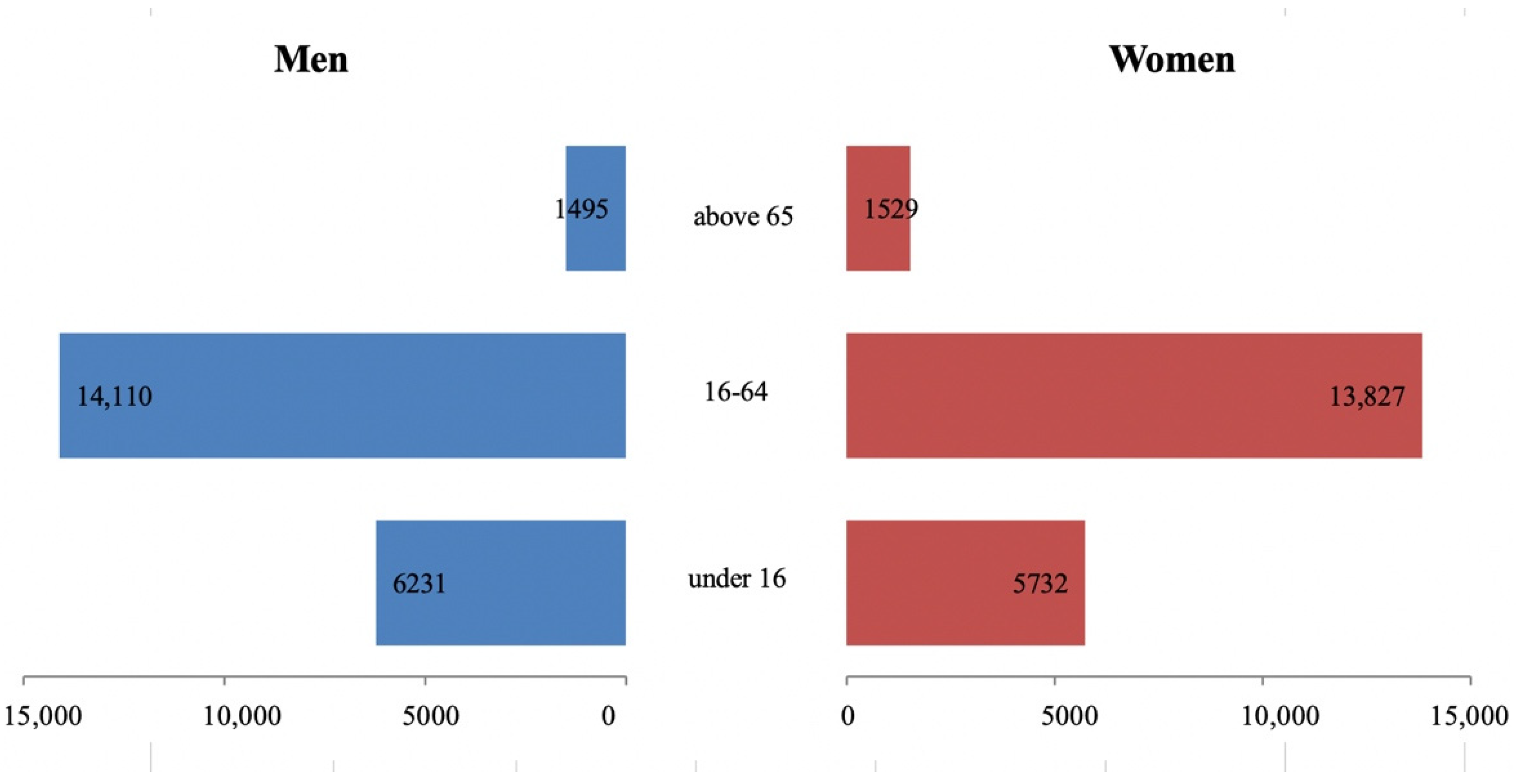
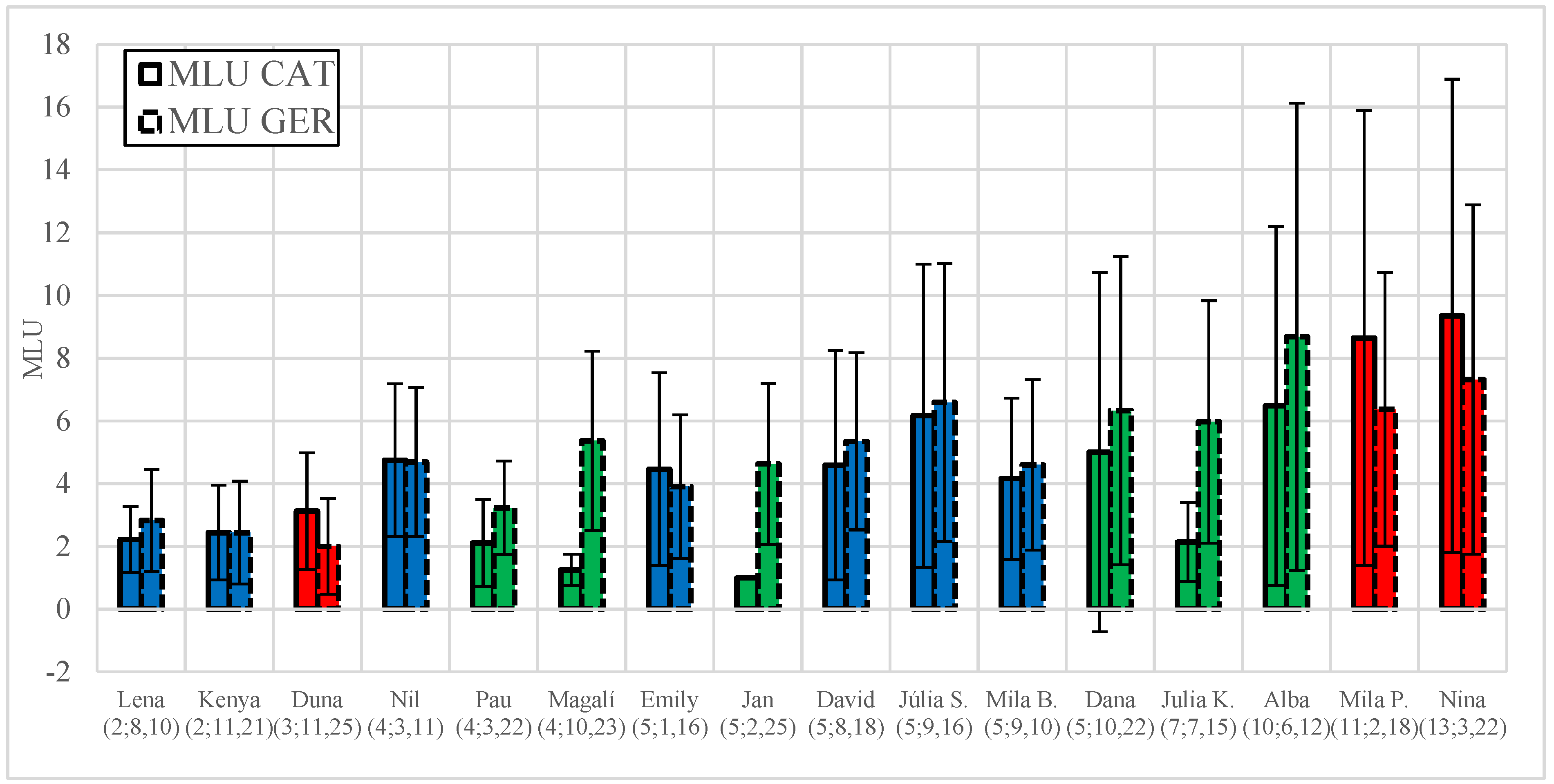
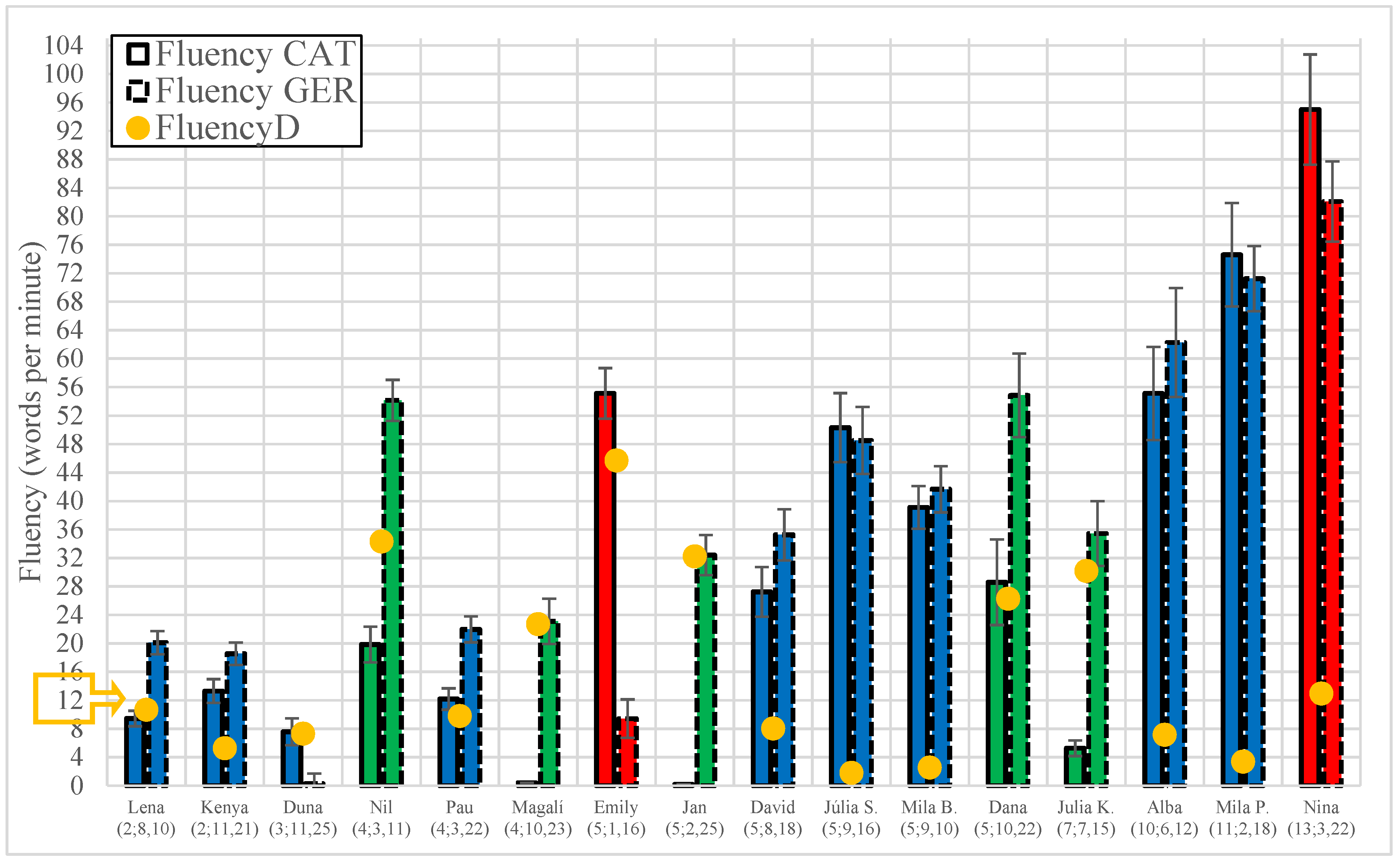
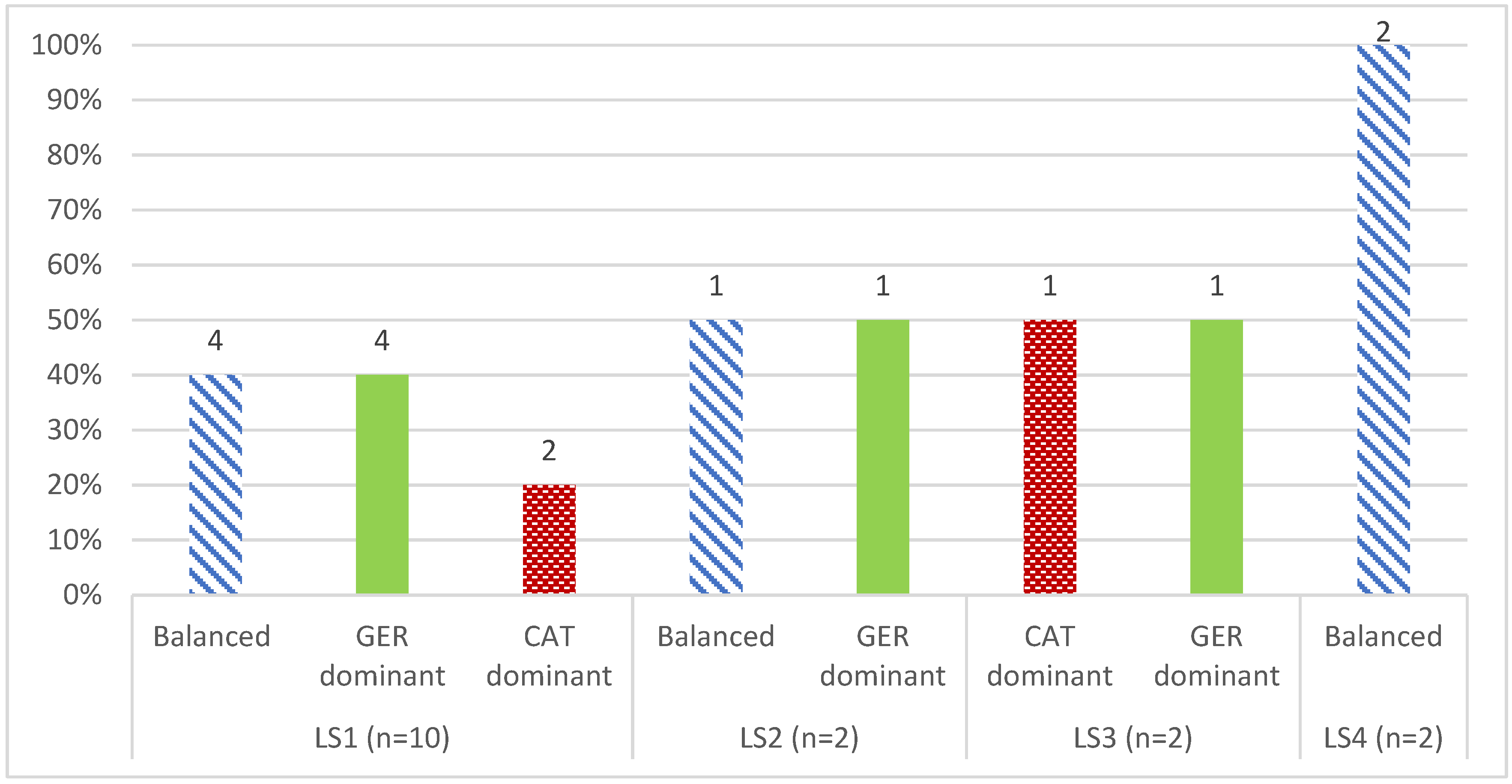
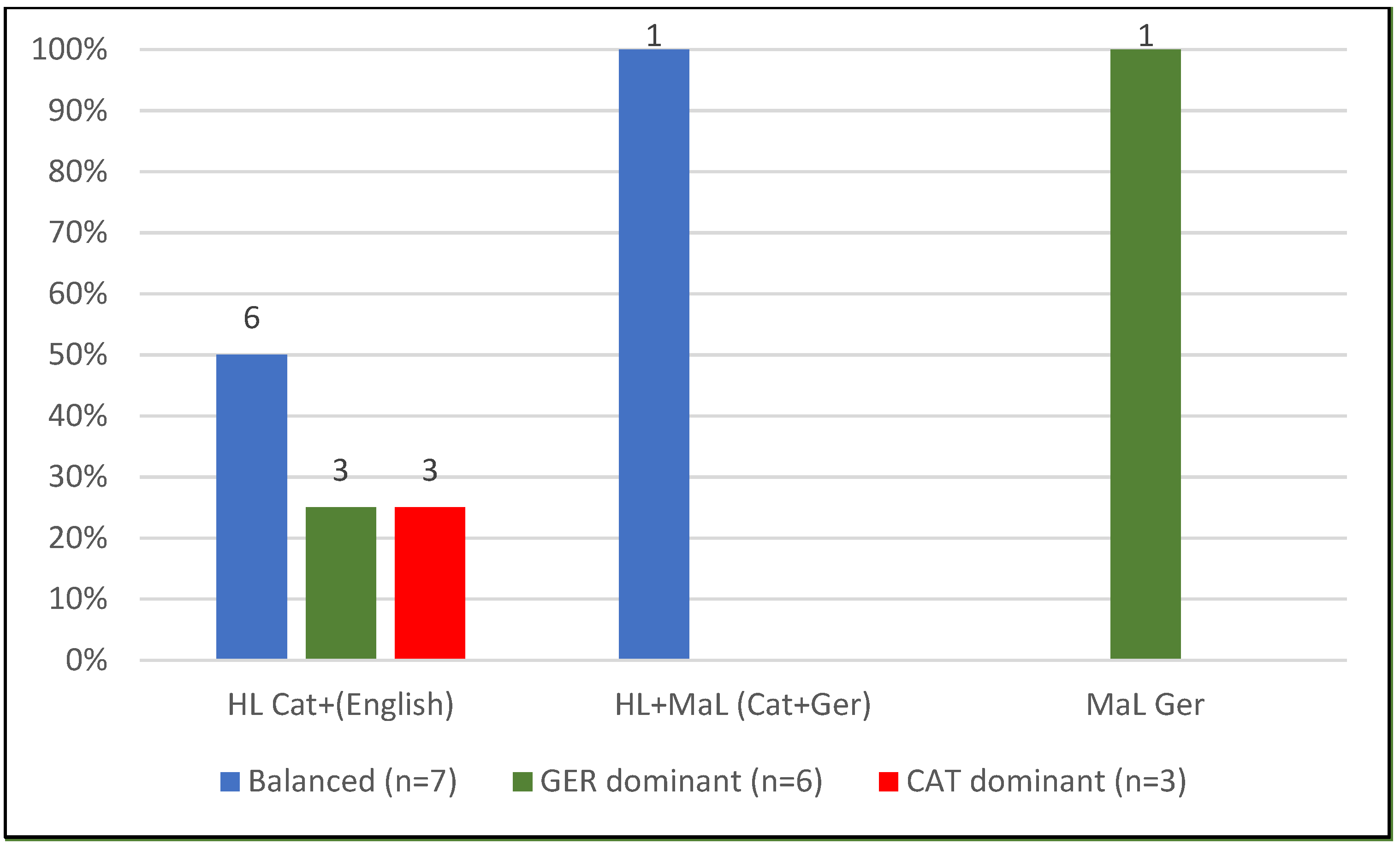

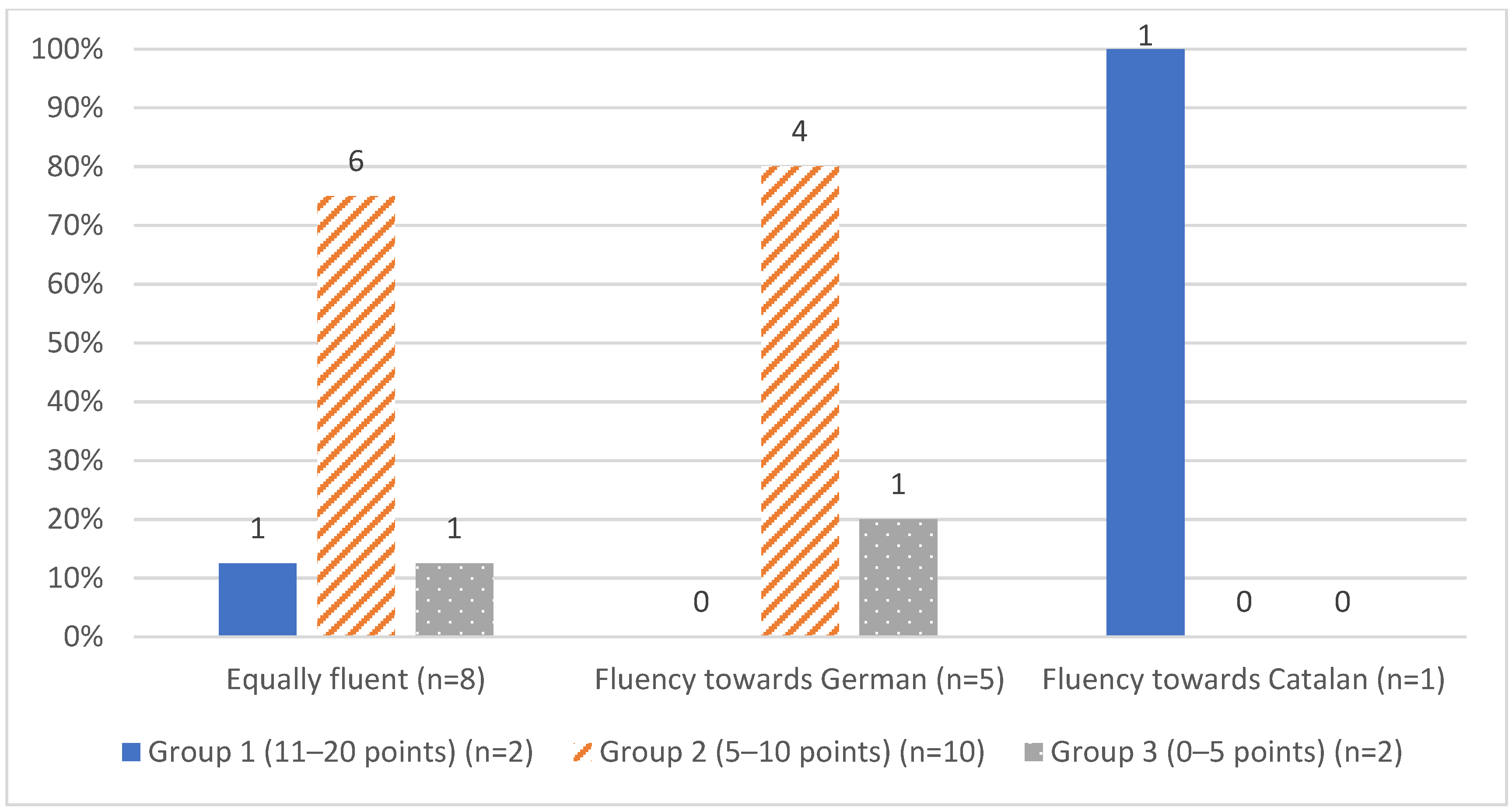
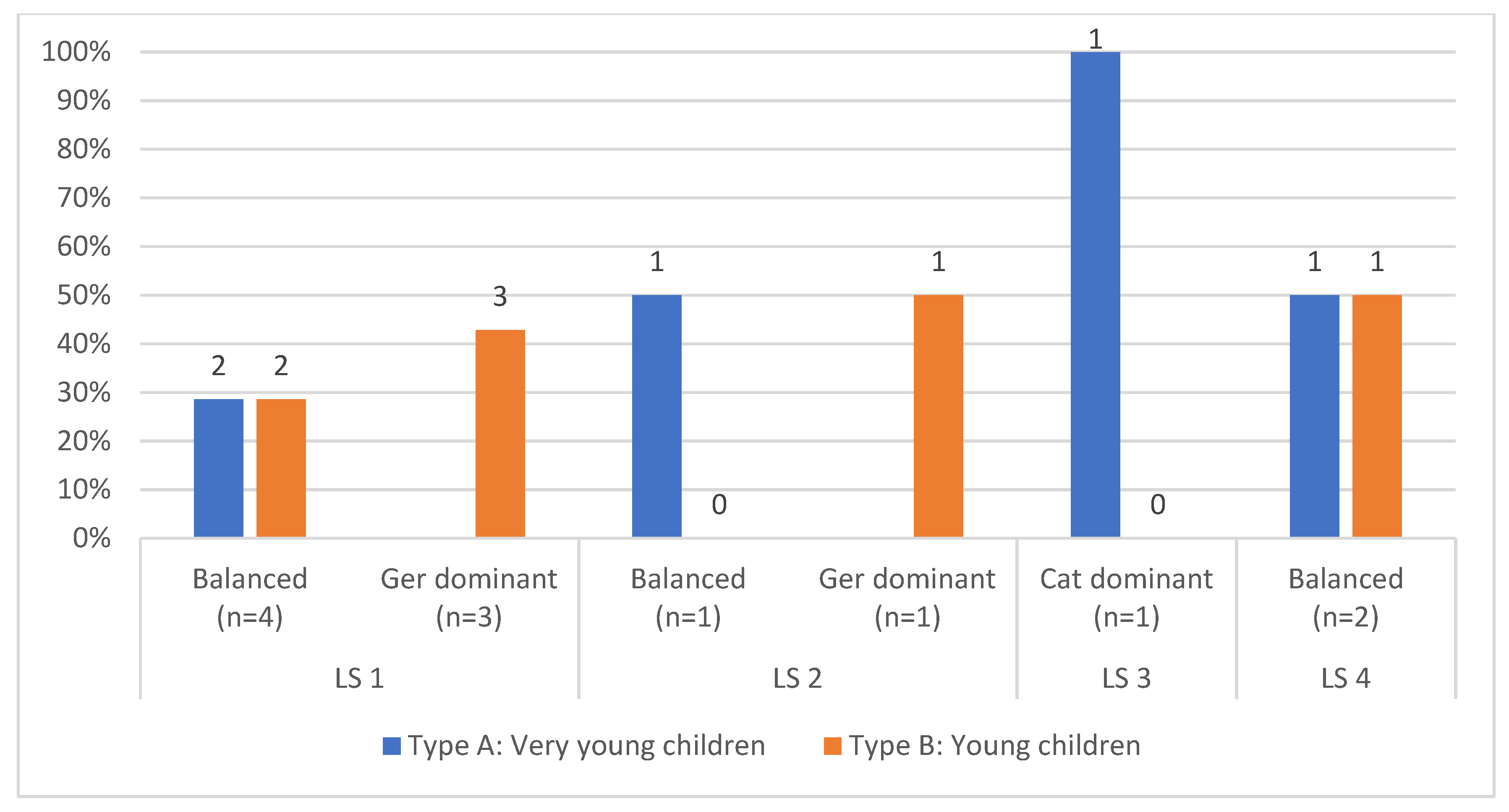
| Child | Age | LA | LB | LC | Information on Sibling Pairs | Parents’ Languages |
|---|---|---|---|---|---|---|
| Lena | 2;8,10 | Catalan | German | Ger–Cat | ||
| Kenya | 2;11,21 | Catalan | German | Sibling pair 1 | Ger–Cat | |
| Duna | 3;11,25 | Catalan | German | Catalan | ||
| Nil | 4;3,11 | Catalan | German | English | Sibling pair 2 | Ger–Cat |
| Pau | 4;3,22 | Catalan | German | Thai | Cat–Thai | |
| Magalí | 4;10,23 | Catalan | German | Ger–Cat | ||
| Emily | 5;1,16 | Catalan | German | English | Ger–Cat | |
| Jan | 5;2,25 | Catalan | German | Sibling pair 3 | Ger–Cat | |
| David | 5;8,18 | Catalan | German | Ger–Cat | ||
| Júlia S. | 5;9,16 | Catalan | German | Ger–Cat | ||
| Mila B. | 5;9,10 | Catalan | German | English | Sibling pair 2 | Ger–Cat |
| Dana | 5;10,22 | Catalan | German | Sibling pair 1 | Ger–Cat | |
| Julia K. | 7;7,15 | Catalan | German | Sibling pair 3 | Ger–Cat | |
| Alba | 10;6,22 | Catalan | German | Catalan | ||
| Mila P. | 11;2,18 | Catalan | German | Sibling pair 1 | Ger–Cat | |
| Nina | 13;3,22 | Catalan | German | Sibling pair 1 | Ger–Cat |
| Section | Focus | |
|---|---|---|
| A | Children’s general information | Personal information such as name, date of birth, gender, place of birth and residence. |
| B | Information on the children’s linguistic environment | Personal information about parents and the languages used in the child’s environment. |
| C | Language fluency | Languages the child is exposed to, and speaks, with the different people with whom (s)he spends time, and how often. |
| D | Literacy (<6;0) | Frequency of different comprehension and production activities in the different L1s of the child, depending on his/her age (younger or older than 6 years of age). |
| E | Literacy (>6;0) | |
| F | Linguistic domains (>6;0) | Frequency of use of children’s L1s in specific linguistic domains, such as writing an email or a letter. |
| G | Cumulative input | Frequency of use of children’s L1s during the different stages of their life (preschool, primary and secondary school). |
| H | Family linguistic competencies | Linguistic competencies in the different skills (understanding, speaking, writing, and reading) of parents and siblings in German, Catalan, and Spanish. |
| I | Children’s assessments about his/her linguistic competencies in his/her different L1s | Linguistic competencies in the different skills (understanding, speaking, writing, and reading) of children in German, Catalan, and Spanish, as well as their attitudes towards the different languages they use. |
| J | Travelling (to Catalan-speaking regions) | Frequency and languages used in Catalan-speaking regions per year. |
| K | Family (including the child) assessments about bilingualism/multilingualism | Assessments about the importance of understanding, speaking, writing, and reading Catalan, German, and Spanish. |
| Input Quantity Factors | Input Quality Factors |
|---|---|
| Amount of input | Family‘s linguistic competencies |
| Cumulative input | Cultural contact |
| Family language policies (FLP) | Language fluency (ling. domains) |
| Language constellation | Amount of family support towards bilingualism/multilingualism |
| Similar Language Fluency for Both L1s | Higher Language Fluency for German | Higher Language Fluency for Catalan | TOTAL | |
|---|---|---|---|---|
| Balanced | 5 | 1 | 1 | 7 |
| German dominant | 2 | 4 | 0 | 6 |
| Catalan dominant | 317 | 0 | 0 | 3 |
| TOTAL | 10 | 5 | 1 | 16 |
| LS 1: ‘one person–one language’(OPOL) with home support of the majority language |
| LS 2: OPOL with an extra majority language outside home |
| LS 3: one language–one environment |
| LS 4: bilingual parents with mixed languages |
| Family Language | Family Language Strategy | Children | Language Dominance |
|---|---|---|---|
| None | LS 1: OPOL + support of MaL | Kenya P. (2;11) David (5;8) Júlia S. (5;9) | Balanced |
| Dana P. (5;10) | German dominant | ||
| Mila P. (11;2) Nina P. (13;3) | Catalan dominant | ||
| LS 2: OPOL + MaL outside home | Pau (4;3) | German dominant | |
| German | LS 1: OPOL + support of MaL | Lena (2;8) | Balanced |
| Magalí (4;10) Jan K. (5;2) Júlia K. (7;7) | German dominant | ||
| English | LS 2: OPOL + MaL outside home | Emily (5;1) | Balanced |
| LS 4: bilingual parents with mixed languages | Nil B. (4;3) Mila B. (5;9) | ||
| Catalan | LS 3: one language–one environment | Duna (3;11) Alba (10;6) | Balanced |
| Catalan | Catalan+English/German | German | |
|---|---|---|---|
| Balanced fluency | 8 (80%) | 2 (20%) | |
| Fluency towards German | 1 (20%) | 1 (20%) | 3 (60%) |
| Fluency towards Catalan | 1 (100%) |
| Child | Age | Non-Native-Catalan-Speaking Parent | Communicative Skills | Total Knowledge of Catalan (L2) |
|---|---|---|---|---|
| Mila P. | 11;2,18 | L1 German | 5/10 | 7/20 |
| Nina P. | 13;3,22 | |||
| Dana P. | 5;10,22 | |||
| Kenya P. | 2;11,21 | |||
| Mila B. | 5;9,10 | L1 German | 3/10 | 3/20 |
| Nil B. | 4;3,11 | |||
| Julia K. | 7;7,15 | L1 German | 5/10 | 8/20 |
| Jan K. | 5;2,25 | |||
| Alba | 10;6,22 | None | - | - |
| Júlia S. | 5;9,16 | L1 German | 5/10 | 8/20 |
| David | 5;8,18 | L1 German | 5/10 | 9/20 |
| Emily | 5;1,16 | L1 English | 10/10 | 19/20 |
| Magalí | 4;10,23 | L1 German | 3/10 | 5/20 |
| Pau | 4;3,22 | L1 Thai | 7/10 | 12/20 |
| Duna | 3;11,25 | None | - | - |
| Lena | 2;8,10 | L1 German | 4/10 | 7/20 |
| Comprehension Activities | Production Activities |
|---|---|
| Listening to stories | Explaining stories |
| Watching cartoons | Singing songs |
| Listening to songs | Counting from 1 to 10 |
| Talking to him/herself |
| Remembering a Telephone Number |
| Using swear words |
| Telling the time |
| Reading a shopping list |
| Reading out loud |
| Talking to him/herself |
| Balanced | German Dominant | Catalan Dominant | ||
|---|---|---|---|---|
| Comprehension activities | Catalan | 39% | 33% | 54% |
| German | 39% | 55% | 32% | |
| Other | 22% | 12% | 14% | |
| Production activities | Catalan | 36% | 23% | 30% |
| German | 49% | 65% | 60% | |
| Other | 15% | 12% | 10% |
| Children | Input during First Year of Life | Catalan Parent (Child’s Language(s) to the Catalan Parent) | Parents’ Linguistic Skills in the L2 Catalan | Language Dominance | Language Fluency |
|---|---|---|---|---|---|
| Lena (2;8,10) | CAT/GER | Mother (CAT/GER) | (2) Satisfactory | Balanced | None |
| Kenya (2;11,21) | CAT/GER | Mother (CAT) | (2) Satisfactory | Balanced | None |
| Nil (4;3,11) | CAT/GER | Mother (CAT/ENG) | (3) Insufficient | Balanced | GER |
| Emily (5;1,16) | CAT/ENG | Mother (CAT) | (1) Good | Balanced | CAT |
| David (5;8,18) | CAT/GER | Mother (CAT) | (2) Satisfactory | Balanced | None |
| Júlia S. (5;9,16) | CAT/GER | Mother (CAT) | (2) Satisfactory | Balanced | None |
| Mila B. (5;9,10) | CAT/GER | Mother (CAT/ENG) | (3) Insufficient | Balanced | None |
| Pau (4;3,22) | CAT/THAI | Father (CAT) | (1) Good | GER dominant | None |
| Magalí (4;10,23) | CAT/GER | Father (GER) | (2) Satisfactory | GER dominant | None |
| Jan (5;2,25) | CAT/GER | Mother (GER) | (2) Satisfactory | GER dominant | GER |
| Dana (5;10,22) | CAT/GER | Mother (CAT) | (2) Satisfactory | GER dominant | None |
| Julia K. (7;7,15) | CAT/GER | Mother (GER) | (2) Satisfactory | GER dominant | GER |
| Alba (10;6,12) | CAT | Mother (CAT) | None | GER dominant | None |
| Duna (3;11,25) | CAT | Parents (CAT) | None | CAT Dominant | None |
| Mila P. (11;2,18) | CAT/GER | Mother (CAT) | (2) Satisfactory | CAT Dominant | None |
| Nina (13;3,22) | CAT/GER | Mother (CAT) | (2) Satisfactory | CAT Dominant | GER |
Publisher’s Note: MDPI stays neutral with regard to jurisdictional claims in published maps and institutional affiliations. |
© 2022 by the authors. Licensee MDPI, Basel, Switzerland. This article is an open access article distributed under the terms and conditions of the Creative Commons Attribution (CC BY) license (https://creativecommons.org/licenses/by/4.0/).
Share and Cite
Arnaus Gil, L.; Jiménez-Gaspar, A. Catalan as a Heritage Language in Germany. Languages 2022, 7, 43. https://doi.org/10.3390/languages7010043
Arnaus Gil L, Jiménez-Gaspar A. Catalan as a Heritage Language in Germany. Languages. 2022; 7(1):43. https://doi.org/10.3390/languages7010043
Chicago/Turabian StyleArnaus Gil, Laia, and Amelia Jiménez-Gaspar. 2022. "Catalan as a Heritage Language in Germany" Languages 7, no. 1: 43. https://doi.org/10.3390/languages7010043
APA StyleArnaus Gil, L., & Jiménez-Gaspar, A. (2022). Catalan as a Heritage Language in Germany. Languages, 7(1), 43. https://doi.org/10.3390/languages7010043






